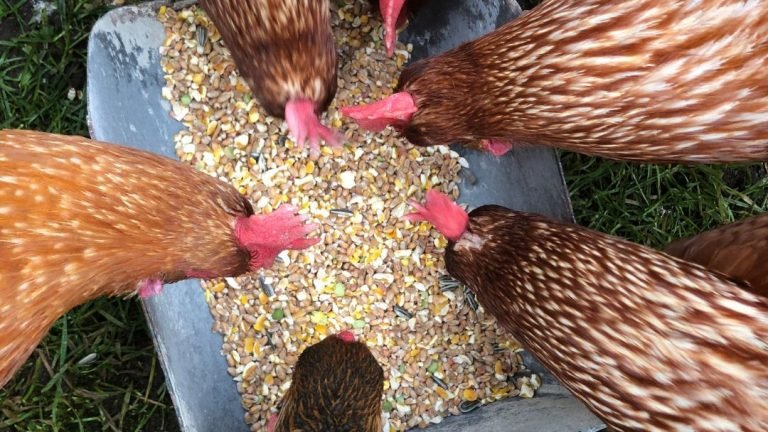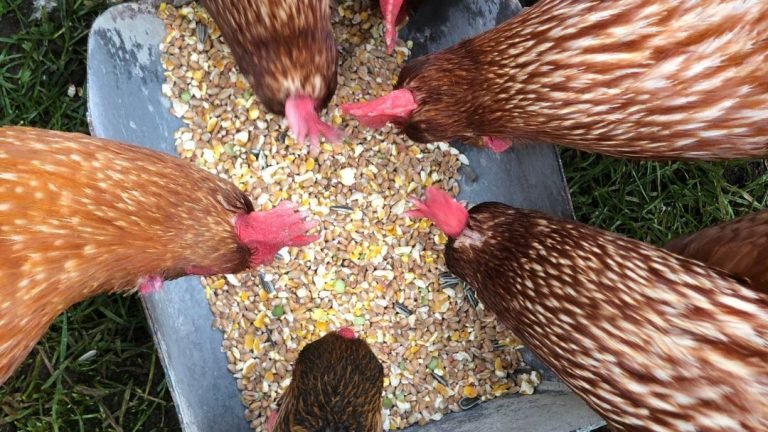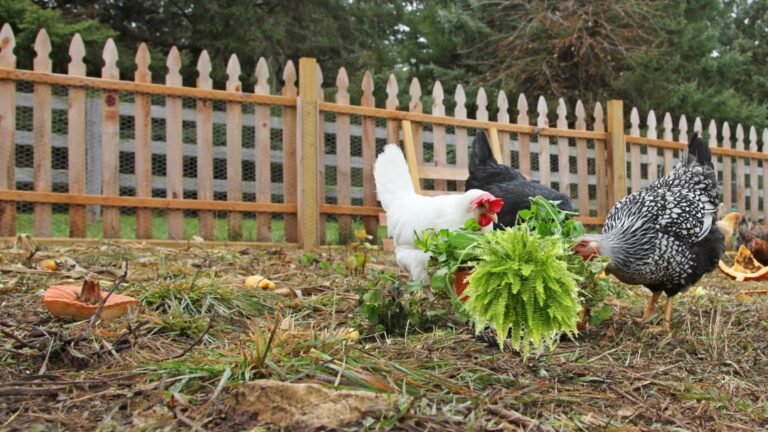Have you seen a finely ground hard substance that is served to chickens? It is known as grit. This type of food served two purposes. It strengthens the eggshells and improves the chickens’ digestive system to digest different kinds of food easily.
Does chick starter feed have grit? Chick starter feed has no grit as all the ingredients are thoroughly and finely mixed. Flocks can digest starter feed easily without any additional grit. But if you serve them other feed, provide them grit.
Does Chick Starter Feed Have Grit?
All the ingredients of chick starter feed are thoroughly and finely mixed. So, starter feed doesn’t require extra grit.
Baby chicks can easily digest this food without having any problems.
However, if you feed any food other than starter feed, serve them with grit. It is necessary until they become 8 weeks old.
If you want to feed them treats or clumps of grass or dandelions, serve grit separately beside the chicken food.
Add insoluble or flint grit when feeding any food other than starter feed.
It helps baby chicks to digest various types of food effortlessly.
Their stomach will not have to work harder to absorb the food.
What Is Grit For Chickens?
Grit is a finely ground hard substance for chickens to support their digestive system.
Generally, two kinds of grit are available for chickens: Oyster Shell Grit and Flint or Insoluble Grit.
01. Oystershell Grit
Oystershell grit contains particular calcium necessary to strengthen eggshells and produce strong bones.
The grit is typically composed of 95-99% calcium carbonate.
It is also known as soluble grit because it will dissolve in the chicken’s gut.
Its body will absorb it and store it to make shells and strengthen bones in the future.
Besides, around 75% of chicken keepers use this common dietary supplement as it reduces the incidence of egg breakage in laying hens.
| Component | Approximate Percentage |
|---|---|
| Calcium carbonate | 90-95% |
| Magnesium | 1-2% |
| Potassium | <1% |
| Iron | <1% |
| Trace elements | <1% |
| Protein | <1% |
| Carbohydrates | <1% |
02. Flint Or Insoluble Grit

Flint grit is a non-soluble grit. It is composed of tiny stones or small pea-sized gravel chips.
This special food supplement provides mechanical support to chickens’ crops for breaking down the food and digesting them quickly.
These tiny pieces of food are made from flint or granite milled.
When you serve any additional food other than starter feed to your baby chicks, flint or insoluble grit is necessary.
You should feed this very fine substance until it becomes 8 weeks old.
It improves the overall gizzard function and feed conversion ratio of younger chickens.
| Component | Approximate Percentage |
|---|---|
| Silicon dioxide | 70-90% |
| Aluminum oxide | 5-15% |
| Iron oxide | 1-3% |
| Calcium oxide | 1-3% |
| Magnesium oxide | <1% |
| Potassium oxide | <1% |
| Sodium oxide | <1% |
Why Is Grit Important For Chickens?
Chickens have one of the most effective digestive systems. But they don’t have any teeth.
Instead, chooks have a powerful muscle called a gizzard. When they eat any food, it passes from the gizzard to the small intestines.
They don’t waste too much time chewing up. Instead, they swallow food quickly.
Flocks need to eat small pieces of rock, grit, and gravel to digest other foods, such as seeds, grains, bugs, grasses, etc.
These tiny pebbles or crushed stones will grind up other food in the gizzard.
100% crushed quartzite grit can help chickens digest different food types easily.
If chickens don’t eat any grit, it may block their digestive system.
Plus, their feed conversion rate will decrease. They will feel uncomfortable and become sick. Chooks may even die if not treated on time.
Is It Mandatory To Feed Grit To All Chickens?
It depends on what types of food your chickens eat. Baby chicks under 8 weeks old don’t need any grit as long as you only feed them chick starter feed.
Even adult flocks don’t need grit if you feed them only commercial layer pellets or crumble, as it can swiftly dissolve in their digestive tract.
But if you feed other natural foods, such as vegetation, grasses, insects, worms, slugs, snails, seeds, and berries, they need the grit to digest this food.
Grit is pretty affordable. They stay fresh for a prolonged period. You should delay feeding them grit when it is necessary to provide them.
When Should You Start Feeding Grit To Chickens?
It is necessary to feed grit to chickens when they start eating various types of food other than commercialized pellets or crumbles.
They usually don’t need it for the first 8 weeks if they only eat chick starter feed.
But once you release them in a free-range area or your backyard, it is necessary to serve grit.
Chooks will eat various treats, such as worms, fruits, greens, vegetables, etc.
Properly digesting this food requires eating grit. Otherwise, their digestive system becomes blocked.
If chickens get enough natural grits, such as a collection of coarse sand, pebbles, and similar small, hard objects, you don’t need to serve grit to them separately.
How To Feed Grit To Chickens?
Chicken keepers should offer grit to chickens on a free-choice basis.
It should be available to the chickens at all times. Avoid forcing them to eat at a particular time.
You want to serve them in a separate container, such as a large, heavy-based dish while keeping it beside the regular food. They can easily peck on it whenever they want.
Grit works like medicine to chickens. They are less likely to over-eat them as it is not treated.
Whenever chickens struggle to digest the food, they will immediately eat grit.
When you serve it for the first time, you can mix it with the regular feed to let them know it is available in a separate container.
If you notice your chooks are overeating grit, hide the pot. However, it is uncommon as grit is not as tasty as treats.
How Much Grit Chickens Need?
It generally depends on the chickens’ age, size, and what food they regularly eat.
Experienced chicken keepers recommended providing around 1-2 pounds of grit per 100 birds per month.
A chicken will generally eat up to 1/20th of their diet in grit.
For example, if a flock consumes around 14 to 16 pounds of feed, it will need approximately 0.75 pounds to 0.8 pounds of grit.
According to several studies, a chicken needs around 30 to 50 grams of small stones or insoluble grit every year.
Make sure they are eating enough grit. Otherwise, they will not get enough nutrition from their feed.
In contrast, overeating grit can negatively affect their digestive system. They may become sick too.
Do Baby Chicks And Adult Chickens Need The Same Grit?
It depends on the size of the grits. If it is a collection of small and larger pebbles and rocks, baby chicks and adult chickens can eat the same grit.
But, it is better to serve special “chick grit” or “baby grit” for baby chicks as their pebbles are smaller than grown-up grit.
Baby chicks need grit when eating treats other than chick starters or crumbles.
Initially, you should sprinkle the grit over the top of their food. It helps them to understand that this food supports their digestive system.
Then, you can serve the grit in a separate container. Chooks will eat them whenever they need.
What Happens If Chickens Don’t Get Grit?
When a chicken doesn’t consume enough grit relative to the amount of feed it eats, it will make its crop full, hard, and swollen.
Their crop or digestive tract is failing to function correctly. It is squishy to the touch.
Chooks will feel uncomfortable, stressed, and in pain, as the crop can’t empty properly.
One of the common problems is an impacted crop if chickens don’t get enough grit.
Chickens usually take around 2-4 hours to empty their crop. However, any blockage in their crop will prevent emptying their crop naturally.
Flocks will struggle to eat normally as they always feel full and a bit like dough.
Another problem chickens are likely to face is a sour crop, which occurs from a disruption of the normal bacteria or Candida albicans and leads to a yeast infection.
This fungal infection in the crop occurs when a chicken fails to empty its crop for an extended period.
What Are The Alternatives Of Grit You Can Feed Chickens?
It is best to feed grit to chickens. But you can try these alternative options if your flocks don’t like them or if it is available in your nearby area.
01. Oyster Shell
One of the best alternative options is Oyster shell.
It is commercially available in a crushed form. This food is made of calcium carbonate with rare impurities.
Oyster shell is known as calcium-rich grit, which can improve chickens’ digestive system and strengthen their bone.
02. Apple Cidre VIngear
Another handy option is Apple Cidre VIngear. Its main job is to increase the PH or acid levels of chickens and aid them in digesting the food smoothly.
It is beneficial when your feathered friends eat high-protein-rich food.
Apple cider vinegar will create additional pepsin in their crop.
This particular enzyme will break down the protein. It may take 30 to 60 minutes to cut through mucus in the chicken’s gut and start digesting the food.
03. Electrolytes
You can also add electrolytes to the water pot. It usually comes in handy during summer, especially for baby chicks.
Chooks may face many heat stress issues, which may lead to dehydration.
Adding electrolytes to their drinking water can help to replenish fluids, maintain electrolyte balance, and support digestion.
After all, electrolytes can keep their digestive system chugging along. It can play a vital role in nutrient absorption and waste elimination.
04. Garlic
Garlic has natural antibiotic properties that can support healthy growth.
You can add garlic into their water pot or let them eat a small proportion of garlic.
It works as a great digestive aid and offers immune support by attacking harmful bacteria in the digestive tract.
This functional fiber generally makes their gut function better by feeding beneficial bacteria in their digestive system.
05. Leafy greens
Chicken keepers only think leafy greens are suitable for making yolks darker and richer.
But they don’t know leafy greens can improve digestion as they contain a specific type of sugar, which can promote the healthy growth of gut bacteria.
Also, leafy greens have insoluble fiber to get a chicken’s intestine to push waste through the ceca, a blind sack along the lower intestinal tract.
Tips For Using Grit On Chickens
- When you mix grit with other chicken feed, the ratio should be between 0.5% to 0.75% of the total feed.
- If chickens eat grit too much, switch to larger particle sizes to limit their consumption.
- Make sure to choose the right type of grit based on your chicken’s age and size.
- Always track how much grit your flocks eat. If they don’t eat enough, use another brand.
- Keep the grit container clean to avoid the risk of bacterial infections.
- Make sure the grit container doesn’t become empty, as chickens need constant accessibility.
Summing UP
Chickens need grit when you serve them regular food. They don’t have teeth. Hence, flocks can’t chew food as precisely as other animals do.
An appropriate grit size can help chooks digest other feeds effortlessly. Make sure to choose the right type of grit based on your chicken’s age and size.
You don’t need to provide grit if your feathered friends only eat commercial layer pellets or crumble. Hopefully, you got a clear answer: ” Does chick starter feed have grit?”







